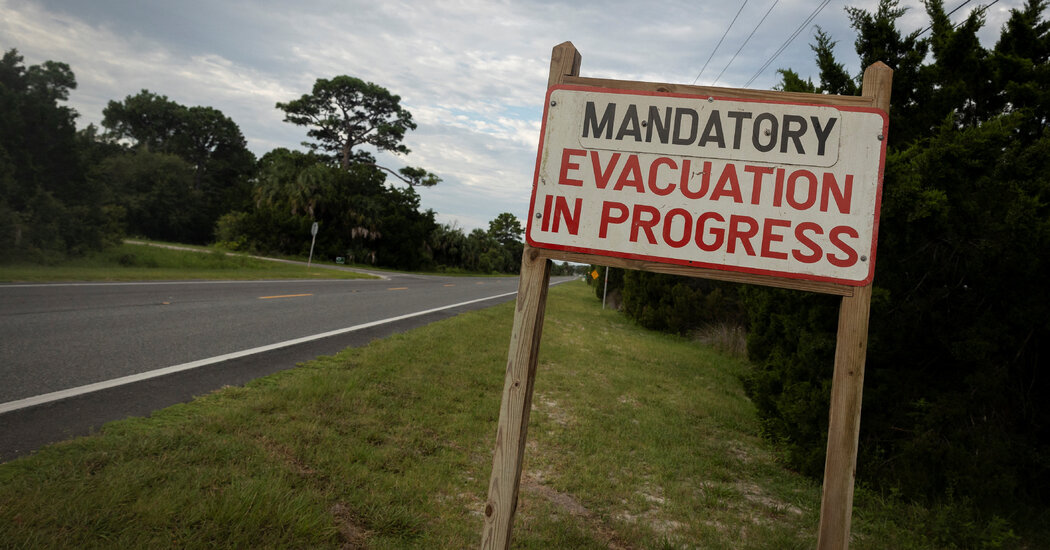This Florida Neighborhood Is Always Bracing for the Next Flood
Hurricane Idalia came ashore last August some 200 miles north of Jennifer Connell-Wandstrat’s neighborhood in St. Petersburg, Fla., but her ranch-style home flooded with nine inches of water that ruined her appliances, doors, dry wall, floors and furniture. She still sleeps on a mattress on the living room floor with her youngest daughter.
Such an ordeal might have once seemed unlikely to ever happen again, at least in a resident’s lifetime. But Ms. Connell-Wandstrat is under no such illusion.
She lives in Shore Acres, a low-lying enclave at the edge of Tampa Bay where streets are broad, homes are comfortable — and floodwater has become a constant threat.
“Now it’s a real fear,” said Ms. Connell-Wandstrat, whose home has flooded twice in three years. “When’s it going to happen next?”
The next hugely damaging storm surge is only a matter of time, she and her neighbors know, especially with forecasters expecting the hurricane season that began on Saturday to be extraordinarily busy. Experts predict there will be 17 to 25 named storms, including four to seven that become major hurricanes with winds of at least 111 miles per hour.
Hurricane Idalia, while not as bad as other recent storms, inundated many neighborhoods far from the strong winds at its center. As climate change leads to higher sea levels and more frequent and intense storms, many more neighborhoods in Florida are expected to become vulnerable to flood risk. In Shore Acres, at least 1,200 of the roughly 2,600 homes flooded with Idalia; many flooded again during a storm in December.
Coping with that reality is not easy, and people in Shore Acres often field questions from relatives and friends asking why they stay.
Some have chosen to leave; “for sale” signs dot almost every block. Others are elevating their homes or razing them and rebuilding higher; imposing three-story structures now stand next to the older, one-story houses.
But many residents, like Ms. Connell-Wandstrat, cannot afford to lift up their homes or retreat. Even with considerable equity in their homes — Ms. Connell-Wandstrat, a tutor whose husband died in 2018, has lived there for 22 years — they are unlikely to find another place they can afford in Shore Acres or a similar neighborhood, given how much property values and mortgage rates have increased.
“I’m here for the foreseeable future,” Ms. Connell-Wandstrat said.
The neighborhood is leafy and walkable, near good schools and close to downtown St. Petersburg and Tampa, which sits across the bay. A large recreation center hosts community activities. A local Facebook group is incredibly active; after Hurricane Idalia, neighbors offered to do each other’s laundry and recommended reliable contractors.
Ms. Connell-Wandstrat, 51, bought in Shore Acres because it struck her as a gem, populated by doctors and lawyers but also teachers and nurses. The less affluent, however, are more vulnerable: The neighborhood is shaped like a bowl, with the more modest homes lying low in the middle.
Back when some of those homes were built in the mid-20th century, the city could only recommend, not require, a certain elevation, said Claude Tankersley, St. Petersburg’s public works administrator. Today, with high-tide flooding rapidly increasing in the Gulf of Mexico, parts of Shore Acres take on water even on sunny days. On a recent afternoon, pools formed at both ends of Ms. Connell-Wandstrat’s block.
After Hurricane Idalia, residents pressed the city to do more. St. Petersburg has since started to install nearly $4 million worth of new equipment to prevent saltwater from pushing up into drainage pipes in the neighborhood, with more projects planned.
Still, Mr. Tankersley said that the projects underway were “a Band-Aid.” Everyone in Shore Acres knows that the best solution other than leaving is to build higher, which can cost hundreds of thousands of dollars. The Federal Emergency Management Agency has a program to assist, but applying is a lengthy process that requires going through the city and state.
Since 1996, St. Petersburg, a city of about 260,000, has helped raise 13 homes, Mr. Tankersley said, with another one currently being elevated and 14 more in the pipeline.
“To talk about such a drastic change as having to elevate your home and the cost involved, it’s a scary thing,” he said. “We recognize that that’s going to take a long time.”
David and Barbara Noah paid several hundred thousand dollars to elevate their 2,100 square-foot home in 2019, two decades after Mr. Noah first bought it. Their house had never flooded, but their insurance kept climbing and the couple did not want to leave. Their house now sits more than 16 feet off the ground.
“We get to stay in our neighborhood that we like and we’ve been in for 20 years, and essentially be safe,” Mr. Noah said.
Had they kept the house at its original 3.5-foot elevation, Mr. Noah estimated that it would have taken on three feet of water during Tropical Storm Eta in 2020 and perhaps four feet during Hurricane Idalia last year. The morning after Idalia, the Noahs tried to help neighbors who were wading through waist-deep water and hoisting their belongings in trash bags. Ms. Noah said the experience made her uneasy.
“There’s that guilt factor,” she said. “Just seeing them go through it, repeatedly, in the time that I’ve lived here — it’s hard.”
Since then, they have watched neighbors put their homes up for sale. Mr. Noah said many of them moved in during the pandemic and might not have been prepared for life near the water.
“It’s really sad that people thought that they were going to get this dream home in Florida, and then these storms hit,” he said.
Melissa Watson, a 46-year-old surgical nurse, bought her cheery blue house in 2021. She left Ohio for Florida in 2018 after surviving cancer and a divorce. She had lost bids for 17 other houses before her offer was accepted in Shore Acres.
“I didn’t really understand the gravity of the flooding that had occurred in this area until after I signed on the dotted line,” she said.
A foot-and-a-half of water flooded her home during Hurricane Idalia, forcing Ms. Watson and her teenage son to bounce between a friends’ houses, Airbnbs and hotels for eight months.
To fix the water damage, insurance offered to pay $52,000 to $58,000; contractors told her the work would cost $65,000 to $75,000. She could not afford to elevate the house but raised her air-conditioner and power outlets with an eye toward the next flood.
“My neighbors are selling. I don’t have neighbors across the street. There’s a monstrosity being built right behind me,” she said. “I fear for what this neighborhood is going to end up like.”
Kevin Batdorf, the president of the Shore Acres Civic Association, has pushed city and state leaders to find more ways to keep residents in their homes. He said people had been quoted anywhere from $250,000 to $400,000, depending on the square footage, to lift their home and reconfigure its electrical and plumbing systems.
Mr. Batdorf, a real estate broker, said people were still buying in the neighborhood, even if only to demolish and rebuild. He likened the situation to when Tropical Storm Josephine flooded Shore Acres in 1996. Mr. Batdorf walked through knee-deep water back then to make sure a house his clients wanted had not flooded. The flooding did not detract the buyers.
“I wrote the contract that day, in the water,” he said. “People love living here. It’s the convenience of where it is. It’s paradise.”
In many ways, Ms. Connell-Wandstrat, a mother of four, remains smitten by the neighborhood. “It’s getting up in the morning and smelling the air from the bay, getting that lovely breeze,” she said. “It’s all the beautiful things about Florida.”
But two house floods and 10 to 15 storm evacuations have left her chronically anxious. For her children, Hurricane Idalia felt like a third traumatic event after the pandemic and the death of their father, who Ms. Connell-Wandstrat said had become addicted to painkillers after an injury and overdosed.
Her 9-year-old has lost her bedroom furnishings twice. Her 16-year-old has created an evacuation to-do list on her cellphone. Her 19-year-old has parted with his dad’s old comic books, which were covered with mold. Her 21-year-old has been unable to move back in because of limited space.
But as much as they would like the security of living on higher ground, the family’s memories are all in Shore Acres.
“Every baby I brought in that front door,” Ms. Connell-Wandstrat said. “This is where they took their first steps. This is where our life happened.”
She has installed peel-and-stick tile, stored important belongings in big plastic bins and made plans to raise a precious piece of furniture — the dresser that was in her children’s nursery when they were infants — for the next time a storm comes.
Kitty Bennett contributed research.


